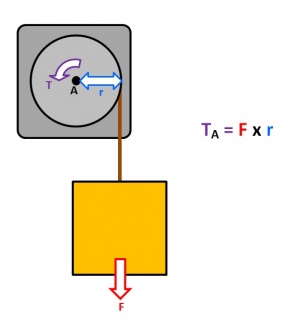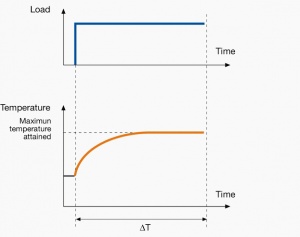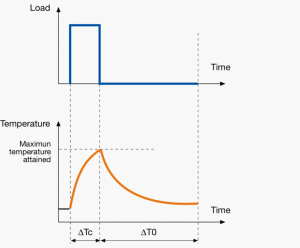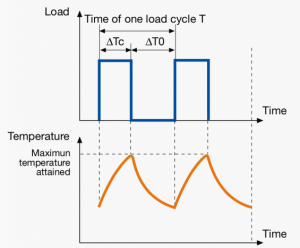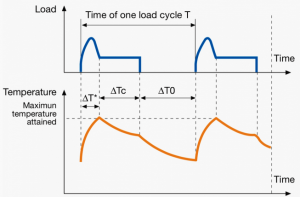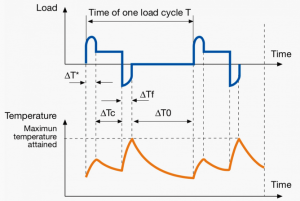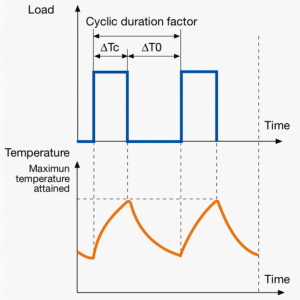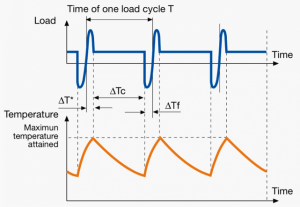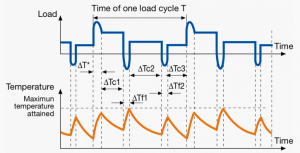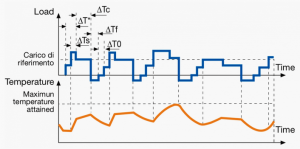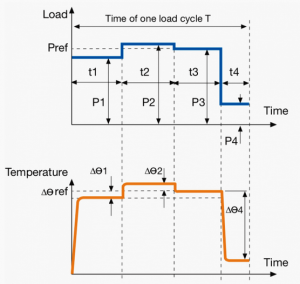Motor selection: Difference between revisions
No edit summary |
|||
| Line 3: | Line 3: | ||
Step 1) Note the load characteristic. | Step 1) Note the load characteristic. | ||
Step 2) | Step 2) Calculate the needed power (torque and speed.) | ||
Step 3) | Step 3) Note the duty cycle. | ||
Step 4) | Step 4) Select motor type. | ||
Step 4) | |||
=Step 1) Note the load characteristic= | =Step 1) Note the load characteristic= | ||
| Line 90: | Line 92: | ||
If the Torque was calculated to 9.81 as in the example above and the speed was assumed to be 10 RPM, the power is calculated like this: | If the Torque was calculated to 9.81 as in the example above and the speed was assumed to be 10 RPM, the power is calculated like this: | ||
P = T * ((2 * pi * N) / 60) = 9.81 * ((2 * pi * 10) / 60) = 1. | P = T * ((2 * pi * N) / 60) = 9.81 * ((2 * pi * 10) / 60) = 10.27 Watt | ||
=Step 3) Note the Duty cycle type= | |||
A duty cycle type specifies the sequence and time duration the motor operation including Starting, Running with no load, Running with a full load, Electric braking, and Rest. How the operations affect motor temperature determines whether increased cooling is needed or whether another motor is suitable. | |||
In the table below, Load refers to the electrical current (measured in Ampere) that is supplied. This electrical load, or current, corresponds to the mechanical load, or torque, measured in Newton meter. More torque requires more current. | |||
"Temperature equilibrium" or "Steady state temperature" refers to temperature that remains constant. | |||
{| class="wikitable" | |||
|- style="font-weight:bold;" | |||
! Type | |||
! Full designation | |||
! Cycle name | |||
! Description | |||
! Load and temperature curve | |||
! Applications | |||
|- | |||
| S1 | |||
| S1 | |||
| Continuous duty | |||
| The motor is turned on and works at a constant Load for enough time to reach Temperature equilibrium. It then keeps going. An example could be a fan that is turned on and kept on. | |||
| [[File:Duty type S1.jpg|300px]] | |||
| Fans, escalators, eMobility solutions, packaging machinery, paper mill drives compressors, conveyers, centrifugal pumps. | |||
|- | |||
| S2 | |||
| Duty type followed by duration of the duty, e.g. S2 40 minutes. | |||
| Short-time duty | |||
| Constant load but not long enough to reach Temperature equilibrium (unlike S1) and instead enters a rest period long enough for the motor to cool down to ambient temperature. | |||
| [[File:Duty type S2.png|300px]] | |||
| Crane drivers, drives for household appliances, sluice gate drives, valve drives and machine tool drives. | |||
|- | |||
| S3 | |||
| Duty type followed by cyclic duration factor, e.g. S3 30%. | |||
| Intermittent periodic duty | |||
| Sequential, identical Run and Rest cycles. The load is constant. Temperature equilibrium is not reached. Unlike S2, the rest periods are not long enough for the motor to cool down to ambient temperature. | |||
| [[File:Duty type S3.png|300px]] | |||
| Plastics machinery, food and beverage processing. | |||
|- | |||
| S4 | |||
| Duty type followed by cyclic duration factor, moment of inertia of the motor JM, and by the moment of inertia of the load JL (both refer to the motor shaft) e.g. S4 20% JM = 0.15 kg m2 JL = 0.7 kg m2. | |||
| Intermittent periodic duty with starting | |||
| Sequential, identical Run and Rest cycles. The load is constant but starting uses more current which leads to a rise in temperature. Neither Run and Rest periods are long enough to attain Temperature equilibrium. | |||
| [[File:Duty type S4.png|300px]] | |||
| Metal cutting, drilling tool drives, mine hoist drives for lift trucks. | |||
|- | |||
| S5 | |||
| Duty type followed by cyclic duration factor, moment of inertia of the motor JM, and by the moment of inertia of the load JL (both refer to the motor shaft) e.g. S5 20% JM = 0.15 kg m2 JL = 0.7 kg m2. | |||
| Intermittent periodic duty with electric braking | |||
| Sequential, identical cycles of Starting, running at constant load, a quick electric braking period, and a period de-energized and at rest. Thermal equilibrium is not reached in one duty cycle. Braking is done electrically and is quick.. No rest periods. | |||
| [[File:Duty type S5.png|300px]] | |||
| Several machine tool drives, drives for electric suburban trains and mine hoist. | |||
|- | |||
| S6 | |||
| Duty type followed by cyclic duration factor e.g. S6 30%. | |||
| Continuous operation with intermittent load | |||
| Sequential, identical cycles of running with constant load and running with no load. No rest periods (unlike S3). Thermal equilibrium is not rached in one duty cycle. | |||
| [[File:Duty type S6.png|300px]] | |||
| Pressing, cutting, shearing and drilling machine drives. | |||
|- | |||
| S7 | |||
| Duty type followed by moment of inertia of the motor JM and the moment of inertia of the load JL (S7 JM = 0.4 kg m2 JL = 7.5 kg m2). | |||
| Continuous operation with electric braking | |||
| Sequential identical cycles of starting, running at constant load and electric braking. No rest periods. | |||
| [[File:Duty type S7.png|300px]] | |||
| Blooming mills for steel manufacturing, supply chain machinery across material handling, some medical technologies, including precision applications. | |||
|- | |||
| S8 | |||
| Duty type followed by moment of inertia of the motor JM, moment of inertia of the load JL, load, speed and cyclic duration factor, for each speed condition (S8 JM = 0.7 kg m2JL = 8kgm2 25kW 800rpm 25% 40kW 1250rpm 20% 25 kW 1000 rpm 55%). | |||
| Continuous operation with periodic changes in load and speed | |||
| Identical duty cycles, each consisting of a time of operation at constant load corresponding to a predetermined speed of rotation, followed by one or more times of operation at other constant loads corresponding to different speeds of rotation. No rest periods. | |||
| [[File:Duty type S8.png|300px]] | |||
| | |||
|- | |||
| S9 | |||
| S9 | |||
| Duty with non-periodic load and speed variations | |||
| Motor is run non-periodically with varying load and speed within the permissible operating range. This duty includes frequently appplied overloads which may greatly exceed the reference load. | |||
| [[File:Duty type S9.png|300px]] | |||
| | |||
|- | |||
| S10 | |||
| Duty type followed by per unit quantities p/Δt for the partial load and its duration, per unit quantity TL which represents the thermal life expectancy of the insulation system related to thermal life expectancy in case of duty type S1 with rated output, and by quantity r which indicates load for a time de-energized and at rest, e.g. S10 p/Δt = 1.1/0.4; 1/0.3; 0.9/0.2; r/0.1 TL = 0.6. | |||
| Duty with discrete constant loads and speeds | |||
| A specific number of discrete values of load maintained for a sufficient time to allow the machine to reach thermal equilibrium. The minimum load during a duty cycle may have value zero and be relevant to a no- load or rest condition. | |||
| [[File:Duty type S10.png|300px]] | |||
| | |||
|} | |||
=Step | =Step 4) Select the motor type= | ||
Here we select one of three motor types. | Here we select one of three motor types. | ||
Revision as of 23:31, 8 July 2022
The selection of motor includes the following steps (which are described in further detail on this page):
Step 1) Note the load characteristic.
Step 2) Calculate the needed power (torque and speed.)
Step 3) Note the duty cycle.
Step 4) Select motor type.
Step 4)
Step 1) Note the load characteristic
There are three different load characteristics:
- Torque that is constant
- Torque that changes abruptly
- Torque that change gradually over time
Note which of these three correspond to your application.
Step 2) Calculate the needed power
To know the needed power, you must first know
- the torque
- the speed
Therefore, Step 2 is broken down into three sub-steps:
2.1) Calculate the needed torque
2.2) Note the needed speed
2.3) Calculate the needed power
Step 2.1) Note the needed torque
T = F * r
where
T: Torque
F: Force
r: Radius
Consider the image to the right as an example for understanding Torque. It shows a pulley connected to a motor lifting a box via a rope. The torque will act on the point A.
The box will pull down with a force:
F = m * g
where
F: Force
m: Mass
g: Gravity of Earth
The gravity of Earth is 9.81 m/s2.
Let's assume the mass M of the box is equal to 10 kilos.
The force F is then calculated like this:
F = m * g = 10 * 9.81 = 90.81 kg * m/s2 = 90.81 N.
Now, the final step to calculating the torque is to multiply the force F by the radius r (the distance from point A to the edge of the pulley.)
Let's assume the radius r is equal to 0.1 m.
The Torque will then be calculated like this:
T = F * r = 90.81 x 0.1 = 9.81 Nm.
Step 2.2) Note the needed speed
Speed N is measured in RPM (revolutions per minute). Note the needed speed for your application.
Step 2.3 Calculate the needed power
P = T * ((2 * pi * N) / 60)
where
P: Power
T: Torque
N: Speed
If the Torque was calculated to 9.81 as in the example above and the speed was assumed to be 10 RPM, the power is calculated like this: P = T * ((2 * pi * N) / 60) = 9.81 * ((2 * pi * 10) / 60) = 10.27 Watt
Step 3) Note the Duty cycle type
A duty cycle type specifies the sequence and time duration the motor operation including Starting, Running with no load, Running with a full load, Electric braking, and Rest. How the operations affect motor temperature determines whether increased cooling is needed or whether another motor is suitable.
In the table below, Load refers to the electrical current (measured in Ampere) that is supplied. This electrical load, or current, corresponds to the mechanical load, or torque, measured in Newton meter. More torque requires more current.
"Temperature equilibrium" or "Steady state temperature" refers to temperature that remains constant.
Step 4) Select the motor type
Here we select one of three motor types.
Servo motors are suitable for high speed and high acceleration requirements. The trade-off is a higher cost and complexity.
Stepper motors are suitable for low speed and low acceleration requirements.
DC motors are suitable for continuous rotation at high RPMs and constant torque across the motor’s speed range.
| Attribute | Stepper motors | Servo motors | Brushed DC motors | Brushless DC motors |
|---|---|---|---|---|
| Accuracy | High | High (achieved by adding encoder to the system. | None | Varies |
| Torque at low speeds | High | High | - | - |
| Torque at high speeds | Low (can lose up to 80% torque at high speeds) | High | - | - |
| Cost efficiency | High | Lower (uses rare-earth magnets, may need encoder or gearbox.) | High | Lower |
| Lifespan | Long life | Shorter | Shorter | - |
| Size | Compact | High output power relative to size and weight. | Compact | - |
| Load capacity | Low (might skip steps at high loads.) | High | - | - |
| Efficiency | Low (constantly draw maximum current independent of load.) | High (80–90% efficiency.) | High | - |
| Ease of use | • Easily controlled (can be controlled with micro controllers such as the ATmega chips that are readily available on Arduino development boards.) Can stall or lose position without a control loop. | • Higher maintenance if gearbox and encoder is included.
• Limited range of motion; positional rotation servos are limited to 180 degrees of motion. • Works in AC or DC drive. |
• Torque to Speed Ratio can be altered (exclusive to brushed motors.)
• High maintenance requirements due to easily worn out as a result of continuous moving contact. |
• Some brushless motors are difficult to control and require a specialized regulator.
• Low maintenance. |
| Applications |
• floppy disk drives • flatbed scanners • computer printers • plotters • slot machines • image scanners • compact disc drives • intelligent lighting • camera lenses • CNC machines and 3D printers • Textile machines • Printing presses • Medical imaging machinery • Small robotics • Welding equipment |
• Automated manufacturing • Robotics • CNC machinery • Telescopes • Elevators • Conveyor Belts • Camera Auto Focus • Solar Tracking System • Metal Cutting & Metal Forming Machines • Antenna Positioning • Printing Presses/Printers • Automatic Door Openers |
• Home appliances • toys • electrical propulsion • cranes • paper machines • steel rolling mills |
• Drones • Electric cars • Washing machines • Air Conditioners • Cordless tools • Computer • Fans • Disk drives |
